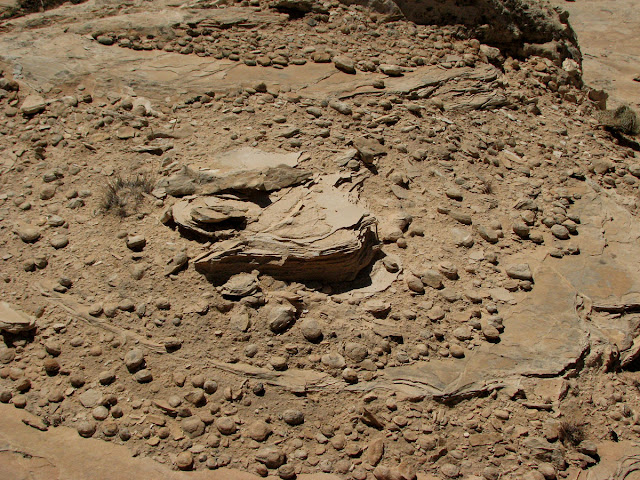Fins, in the world of stone, are tall narrow ridges of stone, usually red sandstone. The arches in Arches National Park are fins that have eroded through in the lower section to form the arch. The Hoodoos, or
towers, of Bryce Canyon National Park are fins that have eroded away leaving sections of the fin standing alone. From our campsite in Paria Canyon we could see a series of fins high above us to the west. We wanted to explore them up close. This kind of hiking, known as bushwacking, is difficult and you need to keep track of where you are because once you are out there the desert all looks alike. Fortunately for us on this hike we were at the edge of a large valley and keeping track of where we were would be pretty easy from any high point. We also had our maps, compass and GPS with us.
Of course we had our "flower picture taking camera" that goes everywhere with us.
Here's a picture of the fins from our campsite. The fins are in the upper left corner and some of the weirder formations we saw are in the upper right corner. The hike didn't look like much when we started and it was only several hundred feet up to the fins.
However, we often found ourselves confronted with walls like this. Oops!
Turn around and find another way.
Route finding in this kind of terrain is always difficult because everything is always much bigger, or farther away, than you thought it was going to be. It took us about an hour to get up into the red rocks.
These fins are made of sandstone, probably Navajo or Entrada type. Sandstone is essentially sand that has been compressed by tons of pressure, over millions of years, until it is rock. These particular
rocks are made of red sandstone. The red color comes from iron that was mixed in with the original sand and oxidized over time, much like rust. The texture of sandstone can vary from hard and smooth, like this, to the very crumbly, rough, and light colored stone like we saw in Cathedral Wash.
Just as we got up near the fins area, we found this bed of fossil clams. We immediately went looking for some fossil butter and fossil cocktail sauce.
Here's what the inside of a fossilized clam looks like. Notice that it is still trapped in the rock and either it was just the bottom or at some point the top got broken away.
Here's one we found free of the base rock, and whole.
This was an inland sea many eons ago.
Sage Lizard.
Exploring the fins was great fun, we saw lots of interesting formations, and got some great views.
Tomorrow we leave for Lake Powell for a couple of days before heading to California.
















No comments:
Post a Comment
Leave your comment here. Please Note: We moderate all comments for appropriateness so it may take as long as a week for your comment to publish if we are Out In De Woods. Please include your name and email address (email address will not be published). If you wish that your comment not be published just ask and I will leave it unpublished.
Thanks.